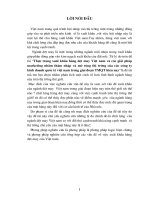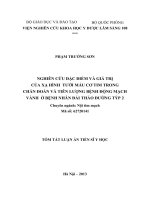Chẩn đoán tim nhanh với QRS giãn rộng Giá trị của các hình ảnh chẩn đoán
Bạn đang xem bản rút gọn của tài liệu. Xem và tải ngay bản đầy đủ của tài liệu tại đây (653.13 KB, 23 trang )
Differential Diagnosis of
wide QRS
Complex Tachycardia
by ECG
Tran Tra Giang
Hanoi Heart Hospital
Introduction
A wide complex tachycardias (WCT) is defined as a rhythm
with a rate >100/min with a QRS duration >120 ms.
The elucidation of the mechanism of WCT is vital not only for acute arrhythmia management, but
also for the further work-up, prognosis and chronic management
Despite the published numerous ECG algorithms and criteria, the accurate, rapid diagnosis in
patients with WCT remains a significant clinical problem, because many of these ECG criteria are
complicated, not applicable in a large proportion of cases and difficult to recall in an urgent setting.
Objective
1.
Evaluate some criteria in ECG of Ventricular Tachycardia.
2.
Evaluate the common Algorithms in differential diagnosis
of WCT by ECG
Method
From 2008 to 8/2016,101 Patients (pts) with WCT
were done diagnosis by EP study.
69 pts were diagnosised on VT
32 pts were diagnosised on SVT
Review the ECG by the common Algorithms.
Common Algorithms.
the Brugada Algorithm
Vereckei Algorithm
Griffith (Bundle Branch Block) algorithm
Ultrasimple Pava criteria
the Brugada Algorithm
(Circulation. 1991;83(5):1649-59)
Absence
of
an
RS
complex
in
all
precordial
leads
yes
No
VT
R to S interval > 100 ms in one precordial lead
Yes
No
VT
AV dissociation
Yes
No
VT
Morphology criteria for
VT present both in
precodial leads V1- V2 and V6
Yes
VT
SVT
Vereckei Algorithm
(Heart Rhythm 2008)
aVR
Lead:
Step 1
Initial R wave in aVR present?
(-)
(+)
VT
Step 2
Initial R wave > 40 ms
(-)
(+)
Step 3
VT
notching on the initialdownstroke of a
predominantly negative QRS complex
(-)
(+)
Step 4
VT
ventricular activation–velocity ratio Vi/Vt ≤ 1
(-)
(+)
VT
SVT
Griffith Algorithm.
LBBB: rS or QS wave in leads V1 and V2, delay
to S wave nadir < 70 ms, and R wave and no Q
wave in lead V6
RBBB: RSr' wave in lead V1 and an RS wave in
lead V6,
with
R
wave height
greater
than
depth
Lancet. 1994 Feb12;343(8894):386-8
S wave
Ultrasimple Pava
criterion
the R wave peak time in Lead II.
They suggest measuring the duration of onset of the
QRS to the first change in polarity (either
nadir Q or peak R) in lead II.
If
the RWPT is ≥ 50ms the
likelihood of a VT very high.
Heart
Rhythm 2010 Jul;7(7):922-6
Statistical analysis
Occurrence of true as well as false-positive and
negative results, as well as sensitivity and
specificity
SPSS for Windows (version 17.0, SPSS Inc., Chicago, IL, USA) was used for
statistical analysis. P .05 value was considered significant.
Patient characteristics
SVT (n=32)
VT (n=69)
P
49 ± 18
<0,05
Age (yrs, mean ±)SD
36 ± 21
Sex (male %)
53,1%
68,1%
<0,05
6,2%
15,9%
<0,01
Structural heart diseases
(%)
Heart rate in
tachycardia (c/min)
156 ± 18
178 ± 27
<0,01
QRS
interval in tachycardia
P<
SVT
0.01
VT
ECG axis deviation
SVT (n=32)
VT (n=69)
P
Normal axis (%)
46,9%
2,9%
<0,01
Right axis (%)
28,2%
28,9 %
NS
Left axis (%)
21,8%
31,9%
NS
Extreme axis (%)
3,1%
36,3%
<0,01
AV dissociation
11,6%
Positive and negative concordance
in the chest lead
21,7%
Josephson’s sign
Notching near the nadir of the S wave
Positive R in
aVR
P<0,01
3,1%
40,5%
QRS
morphology
in
V1
RBBB
V1
V6
V6
SVT
VT
QRS
morphology
SVT
in
VT
LBBB
Sensitivity, specificity, and positive and
negative predictive values of different
Algorithms
Sensitivity
Specificity
Positive predictive value
Negative predictive
(95% CI)
(95% CI)
(95% CI)
value (95% CI)
Vereckei
95,6 (93,6-98,4)
79,7 (64,7-94,2)
94,2 (81,8-99,2)
81,6 (68,1-91,2)
Brugada
88,6 (83,6-91,7)
72,6 (67,4-77,6)
89.5 (84.8–94.2)
67,2 (58.9–75.5)
Griffith
73.2 (67.1–79.4)
84.6 (77.2–90.8)
89.1 (84.2–94.6)
63.2 (55.1–71.8)
Pava
71.6 (67.5–77.8)
83,2 (76.8–90.2)
91.4(88,2–95.3)
52,7 (45.1–60.4)
Conclusion
Review quickly in ECG on WCT include
extreme axis, positive R on aVR, concordance in chest
lead,
Josephson’sign
may be suggested VT
Vereckei algorithms is superior than other
algorithms.
Thank
your
you
attention
Dr Michel Mirowski
(1923-1990)
for
ACC/AHA/ESC
Algorithms.
QRS morphology in precordial leads
(A/V relationship is unknown)
Precordial leads
•Concordant
Typical RBBB
Or
LBBB
•No R/S pattern
SVT
VT
•Onset or R to nadir
Longger than 100 ms
LBBB pattern
RBBB pattern
R in V1> 30 ms
•qR, Rs or Rr in
•Frontal plane axis
V1
VT
R to nadir of S in V1
VT
>60 ms
range from +90
to -90 degrees
qR or qS in V6
Eur Heart J. 2003;24:1857–97.









